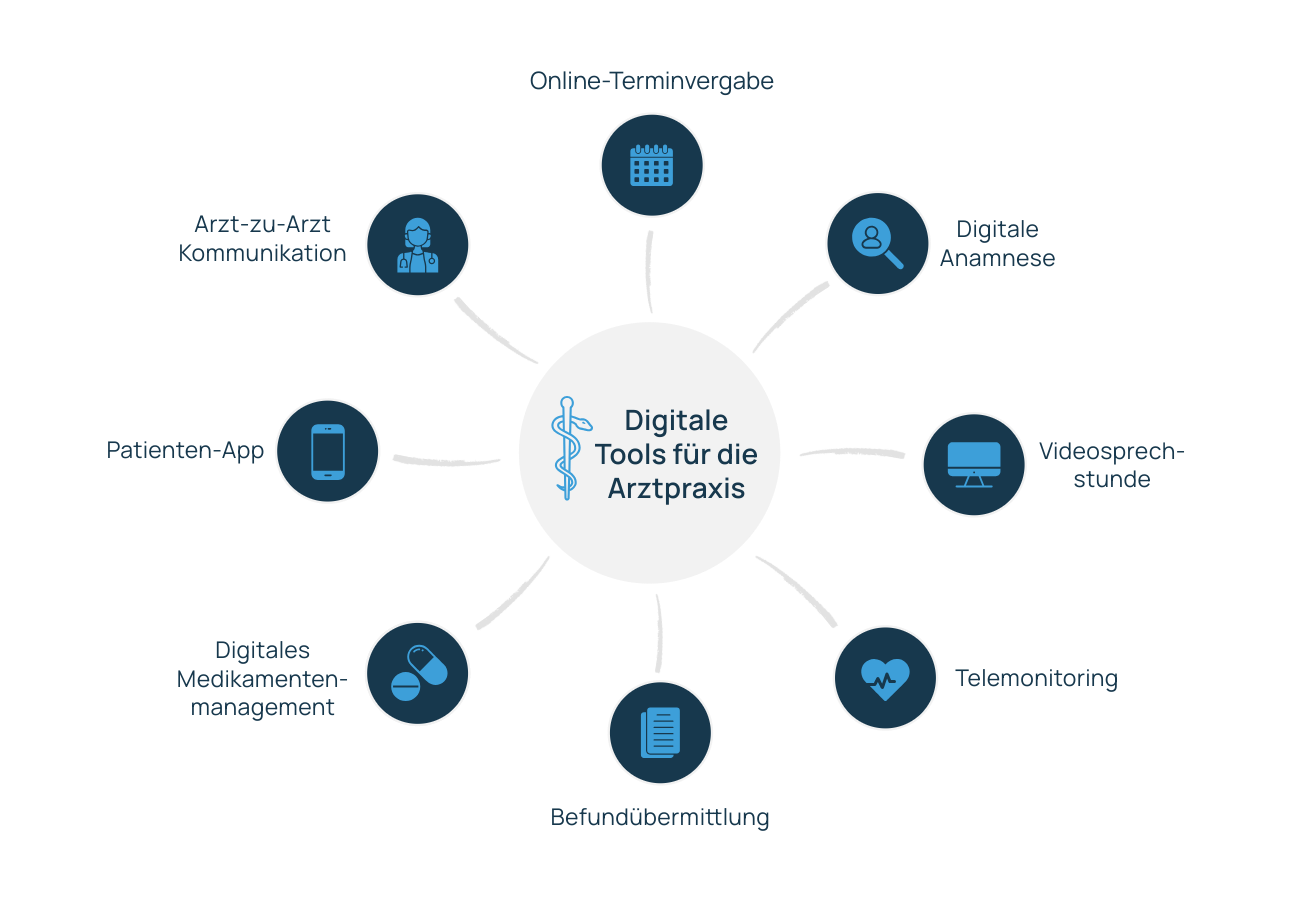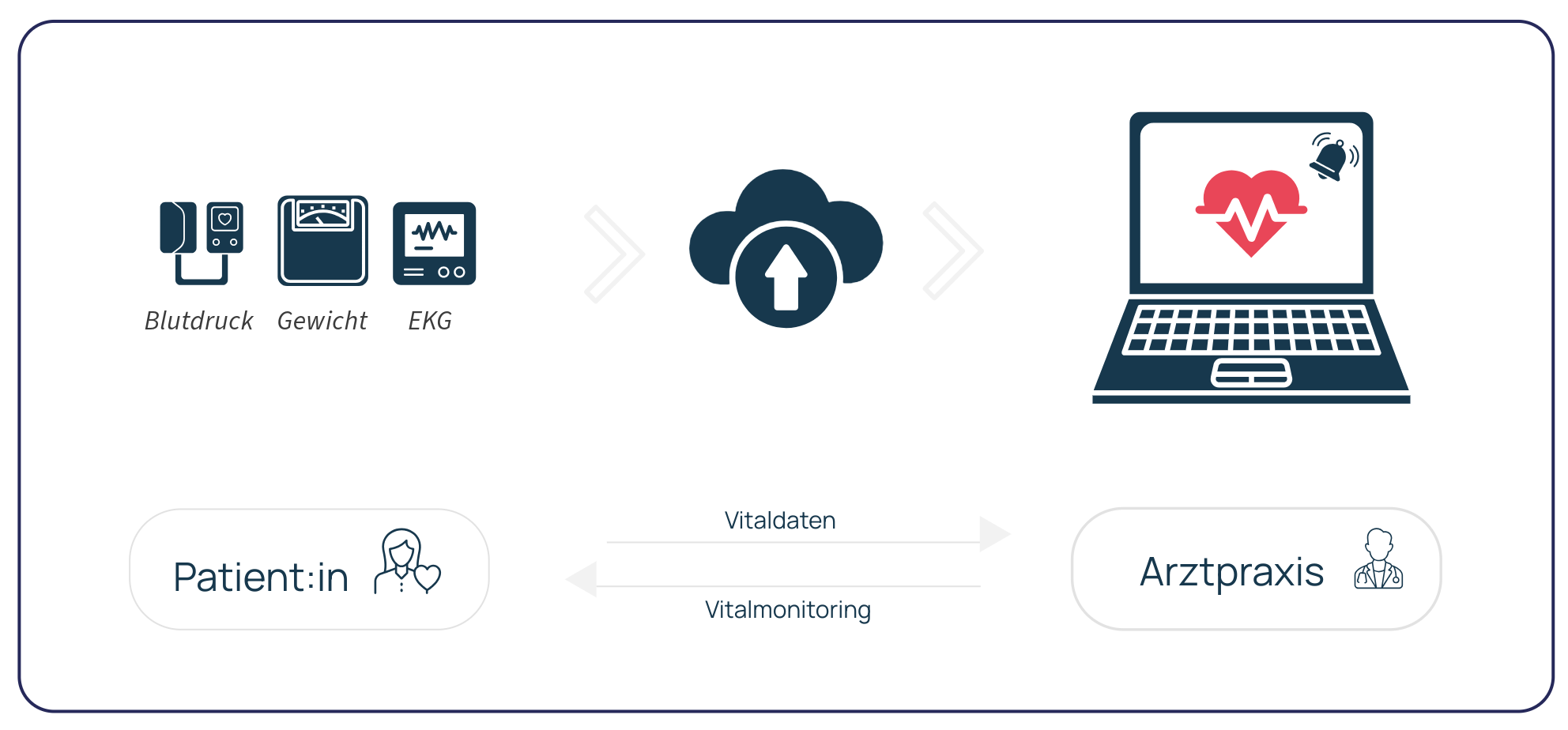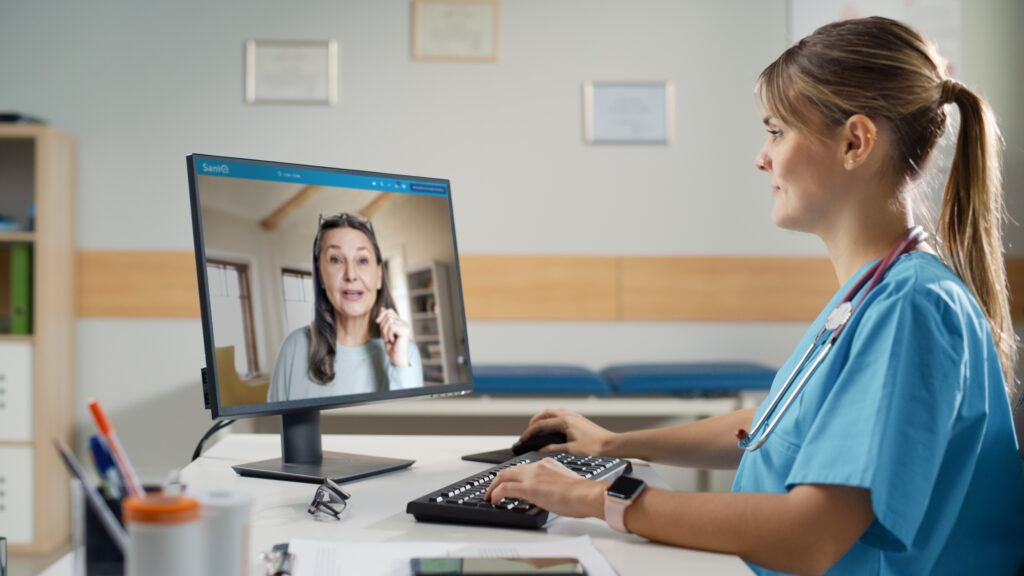Patient care: Digital tools for the medical practice
Patient care: Digital tools for the medical practice
Digitalisation is putting traditional methods of patient care to the test. While practice visits and personal contact remain important, digital technologies offer valuable support. Which digital tools can usefully supplement outpatient patient care?
Digitalisation is putting traditional methods of patient care to the test. While practice visits and personal contact remain important, digital technologies offer valuable support. Which digital tools can usefully supplement outpatient patient care?

Table of contents
Video consultations, e-prescriptions, eAU and ePA - the ongoing digitalisation of healthcare in Germany will be discussed by the BGM as part of the Digitisation strategy for the healthcare sector driven forward.
This opens up new possibilities for medical practices in the treatment and care of patients. Digital tools can significantly increase both the efficiency and quality of patient care - from the medical history to the transmission of findings and beyond.
Advantages of digital patient care
Simplifying access to medical care
Against the backdrop of a shortage of doctors and demographic trends, you can improve medical care for many people with the help of video consultations and the like.
This applies in particular to:
- Patients with limited mobility
- People in underserved areas
- Chronically ill patients with many medical appointments
Efficient design of practice processes
Many medical services do not require patients to be physically present in the doctor's surgery. You can perform these services digitally and efficiently, thereby reducing the workload on your practice and improving capacity utilisation.
This applies, for example, to
- Prescriptions & sick notes
- Measurements of vital signs
- the transmission of findings/laboratory results
Efficient and close-knit care for the chronically ill
With tools such as telemonitoring, digital medication plans, chat and document exchange, the care of patients with chronic illnesses can be organised efficiently and at the same time closely meshed.
e.g. for patients with
- COPD
- Heart failure
- Diabetes
Analogue vs. digital: a comparison of processes in medical practices
The following table compares specific patient care processes in medical practices with and without digital tools:
|
Process
|
analogue
|
digital
|
Advantages
|
|---|---|---|---|
|
Appointment allocation
|
Time-consuming telephone allocation
|
Online appointment booking via practice website or app
|
+ Relief for the practice staff
+ 24/7 availability for patients + Reduction of waiting times |
|
Medical history
|
Paper-based questionnaires
|
Digital anamnesis tools
|
+ Time savings through automated data capture
+ more complete data records + Better readability and accessibility of information |
|
Consultation hour
|
Face-to-face appointments, overcrowded waiting rooms, increased workload for practice teams
|
Video consultation
|
+ Relief for the practice staff
+ Increased patient satisfaction + Reduced idle times and appointment cancellations |
|
Transmission of findings
|
Postal dispatch or personal collection
|
Secure digital transmission via patient app or portal
|
+ faster exchange of information
+ Lower risk of data loss + better documentation |
|
Monitoring chronically ill patients
|
Regular visits to the practice required
|
Telemonitoring: continuous remote monitoring of vital parameters
|
+ Early detection of disease flare-ups
+ Reduction of unnecessary visits to the practice + improved therapy control |
|
Patient communication
|
By telephone or by post
|
Secure communication via patient app or portal
|
+ Faster and more flexible communication
+ better accessibility + documented communication |
|
Medication management
|
handwritten medication plan
|
Digital medication plan with reminder function
|
+ Better overview for doctor and patient
+ easier updating |
|
Doctor-to-doctor communication
|
Letters, faxes or telephone calls
|
Electronic doctor's letter, secure network for doctors
|
+ faster exchange of information
+ More complete transmission of patient data + Improved interdisciplinary cooperation |
|
Patient education
|
Printed information sheets
|
Digital health information in patient app
|
+ More personalised and clearer information
+ better patient understanding + More sustainable information transfer |
|
Process
|
analogue
|
digital
|
Advantages
|
|---|---|---|---|
|
Appointment allocation
|
Time-consuming telephone allocation
|
Online appointment booking via practice website or app
|
+ Relief for the practice staff
+ 24/7 availability for patients + Reduction of waiting times |
|
Medical history
|
Paper-based questionnaires
|
Digital anamnesis tools
|
+ Time savings through automated data capture
+ more complete data records + Better readability and accessibility of information |
|
Consultation hour
|
Face-to-face appointments, overcrowded waiting rooms, increased workload for practice teams
|
Video consultation
|
+ Relief for the practice staff
+ Increased patient satisfaction + Reduced idle times and appointment cancellations |
|
Transmission of findings
|
Postal dispatch or personal collection
|
Secure digital transmission via patient app or portal
|
+ faster exchange of information
+ Lower risk of data loss + better documentation |
|
Vital signs monitoring
|
Regular visits to the practice required
|
Telemonitoring: continuous remote monitoring of vital parameters
|
+ Early detection of disease flare-ups
+ Reduction of unnecessary visits to the practice + improved therapy control |
|
Communication
|
By telephone or by post
|
Secure communication via patient app or portal
|
+ Faster and more flexible communication
+ better accessibility + documented communication |
|
Medication
|
handwritten medication plan
|
Digital medication plan with reminder function
|
+ Better overview for doctor and patient
+ easier updating |
|
Doctor-to-doctor
|
Letters, faxes or telephone calls
|
Electronic doctor's letter, secure network for doctors
|
+ faster exchange of information
+ More complete transmission of patient data + Improved interdisciplinary cooperation |
|
Patient education
|
Printed information sheets
|
Digital health information in patient app
|
+ More personalised and clearer information
+ better patient understanding + More sustainable information transfer |

The digital medical practice
The SaniQ telemedicine platform is a flexible companion for registered doctors and their practice teams on the path to the digital future of healthcare.
The digital doctor's surgery: you should know these tools
Patient app
A patient app can serve as a central interface between your practice and your patients. This enables efficient, modern and secure patient communication and opens up many other options for you.
A well-designed patient app can strengthen the bond with your practice and promote your patients' adherence to treatment.

Useful functions:
- Simple and secure communication between patients and the practice team
- Document exchange
- Medication plan incl. reminder function
- Telemonitoring
Digital anamnesis
With the help of appropriate software, patients can record their medical history and current complaints online before visiting the doctor. This not only saves time, but also increases the precision of the data, as patients can respond without time pressure. For doctors, this means a considerable reduction in the workload in everyday practice and an improved basis for diagnosis and treatment planning.
Telemonitoring
With Telemonitoring you can monitor your patients' vital signs remotely. Your patients regularly measure values such as blood pressure, lung function or glucose at home and transmit them to the practice software via an app.
This is why remote monitoring of chronically ill patients makes sense:
- Automated and continuous monitoring of vital signs
- Early intervention in the event of deterioration (exacerbations, decompensations)
- Reduction in frequent practice visits relieves the burden on patients and everyday practice life
Telemonitoring for chronically ill heart patients could look like this, for example:

Digital medication plan
A digital Medication plan offers you a modern way of controlling and monitoring your patients' medication intake.
Advantages:
- Clear and always up-to-date presentation of the prescribed medication and its dosage for you and your patients
- Reminder function for patients via app
- Monitoring adherence
- Easy adjustment of medication if necessary
Digital document exchange
You can share findings, laboratory results and medication plans securely and directly with your patients via digital document exchange. Conversely, patients can send you important information such as medical history forms or medical findings.
Advantages of digital document exchange:
- Saves time and journeys
- Reduces practice visits
- relieves the practice team
Conclusion
Digital tools can support doctors and practice teams in this,
- to make everyday processes more efficient,
- to meaningfully supplement practical services and
- to provide close-knit care for chronically ill patients.
Digital tools should not replace the personal doctor-patient relationship, but rather complement it in a meaningful way. The physical examination and personal contact with the patient remain central aspects of the doctor's work.
By adopting digital solutions at an early stage, medical practices can keep pace with developments while ensuring the best possible care for patients.
These articles might be of interest to you:

Remote Patient Monitoring for COPD
When will Remote Patient Monitoring for COPD become an integral part of standard care? Initial studies were promising - now a study project funded by the G-BA is set to provide clarity. In this article, we shed light on the current state of research and show what a sensible implementation could look like.

4 compelling reasons in favour of video consultations
Telemedicine is finding its way into German doctors' surgeries: More and more doctors are offering their patients video consultations. What are the reasons behind this development?
